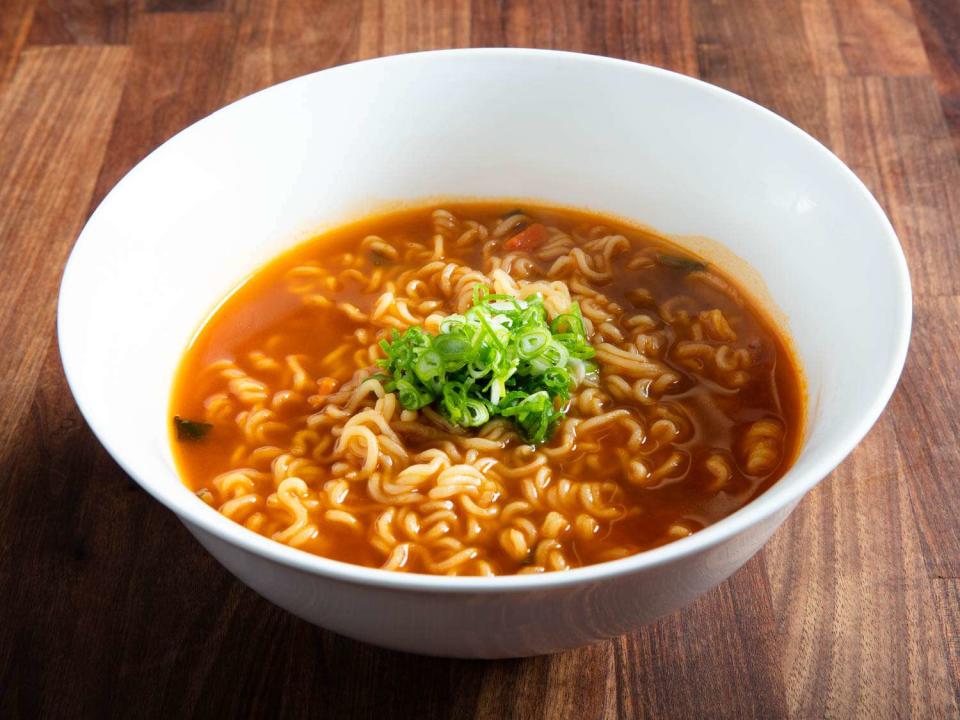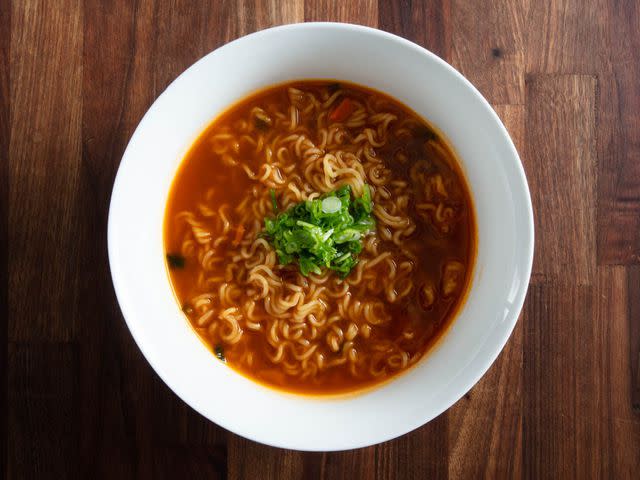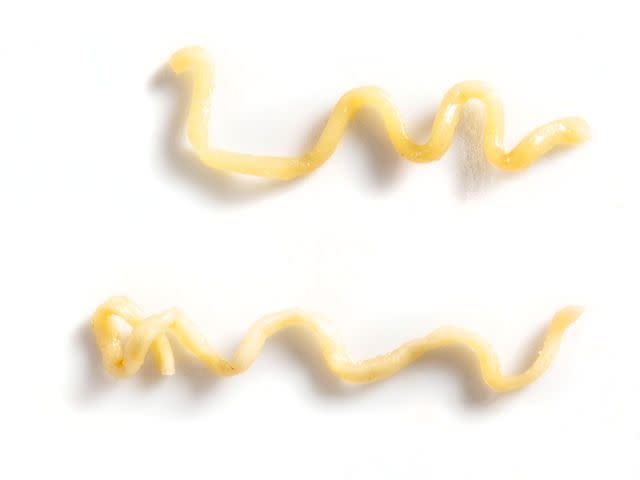Shin Ramyun Is Terrible! (Long Live Shin Ramyun!)
One man's quest to discover why the packet of instant noodles beats the cup of instant noodles every time.

Serious Eats / Vicky Wasik
This story was originally published as part of a column about instant noodles and the opinions expressed are the author's own and do not necessarily reflect those of the Serious Eats staff. As an editor at Serious Eats show also developed not one but three different recipes for homemade ramen noodles.
If the invention of instant noodles in 1958 by Momofuku Ando, a Taiwanese immigrant living in Osaka, Japan, was one of the most consequential events in the history of food in the 20th century (it was), then the Nongshim Corporation’s creation of Shin Ramyun, which first went on sale in the Republic of Korea in 1986, deserves some kind of footnote in the annals of our collective culinary history.
Just as the introduction of the New World potato to the Indian subcontinent ultimately resulted in aloo tikki, the apotheosis of the potato as food, Shin Ramyun appears to me to be the pinnacle of the instant noodle, the point past which any innovation is pointless.
Instant Noodle Perfection
Reasonable people can disagree about which instant noodle is the best; one woman’s Indomie is another’s Sapporo Ichiban, and there’s no accounting for taste, as they say. But it seems silly to deny Shin Ramyun is a perfect product, one that reveals an incredibly sophisticated understanding of both the instant-noodle market and the technologies that make instant noodles possible.
You can point to the beef-broth base as an example and how beef remains relatively uncommon in other very popular instant noodles, or you can point to the fact that it is proudly, even defiantly, spicy (the large Chinese character emblazoned on every pack stands for “shin,” which means “spicy”) when many of its competitors, particularly from Japan, generally settle for aggressively savory. You can also point to the quality of the freeze-dried vegetables in every packet, and the way they signify the original vegetable without actually tasting anything like it—a notional genius that’s similar to what exists in every LaCroix can. But the main way in which Shin Ramyun outstrips its competition is its noodles: they’re glossy, irrepressibly curly, chewy even when overdone, and when it comes to slurping them up, incredibly fun.

Serious Eats /Vicky Wasik
Which is why it’s so mystifying that the Shin Ramyun Cup Noodle is so bad.
Shin Ramyun Missteps
To be sure, Nongshim has made missteps in the past. In April 2011, the company introduced Shin Ramyun Black*, a marketing gimmick passed off as a premium product that nevertheless somehow carved out a section of the instant-noodle economy. The question the Black posed was this: Is there a small segment of the noodle-eating population willing to spend twice as much for their Shin Ramyun, all for a small packet of dust that mimics a creamy paitan consistency? And a sad chorus from a small section of the noodle-eating public answered in the affirmative.
*Which, in 2013, Serious Eats reviewed objectively.
I suppose the Black also includes dehydrated vegetables that are cut a little larger, which ruins that life-likeliness I so admire in the dried stuff in the original and replaces it with the impression that, yes, these are dried vegetables, and—surprise!—dried vegetables are bad. And while the company also describes the Black as having a “pot-au-feu” flavor, adding a lie to the insult of the elevated price, the noodles are the same bouncy, springy, curly (and fun!) ones included in the original, which seemed to suggest that while the company can make (profitable) mistakes with new products and branding exercises, it was savvy enough to play to its main strength.

Serious Eats / Vicky Wasik
Or so I thought. But the other day, bedridden with the flu, I asked my wife to purchase a packet of Shin Ramyun (“Not Black, dear God!” I croaked from under the covers). Instead of coming home with what I wanted, she presented me with the cup noodle version, and I discovered it was inedible. Curiosity piqued, and still bedridden, I asked her to purchase the Shin Bowl versions, along with some Shin Ramyun I could actually eat and discovered that they, too, were of inferior quality. Having established the Shin Ramyun you are compelled to prepare in a pot is vastly superior to the cup or bowl versions, I tried the Shin Black cup and discovered that it, too, contained awful noodles.

Serious Eats / Vicky Wasik
Don’t believe me? Take a look. Here on the bottom is a noodle from the Shin Ramyun Cup and on the top is the perfect original. Where the cup version looks doughy, flaccid, pale, and undeniably soggy, the perfect original looks springy, looks glossy, looks—yes, looks! undeniably!—incredibly delicious, and I can attest that these noodles—literally these noodles on the plate, which I ate directly after they were documented for posterity—eat the way they appeared.
Steep vs. Boil
Of course, the explanation for their differences is obvious: Different preparations require different formulations. Even a relatively new noodle nerd knows slight differences in formula can necessitate different cooking times, so an inferior Shin Ramyun noodle that’s designed to spend three minutes in a tepid water bath will be different than a very good one meant to be cooked like a proper noodle in boiling water. But the salient question is this: Why would Nongshim choose to produce a vastly inferior noodle for the more convenient version of its premier brand? Doesn't it possess the vast resources of a major food brand to devise a noodle destined for flimsy plastic cups and bowls that isn’t bad?
But as I looked at the ingredient list on a Shin Ramyun Cup, it occurred to me that this is not just an issue of chemistry and formulae but one of engineering as well. Suppose for a moment that the producer of a perfect noodle product had devised a reasonable facsimile noodle for use in a similar product designed with convenience in mind, but then was faced with the limitations of packaging and the exigencies of keeping the price of a convenience product as close to nothing as possible? To put it another way, what if it wasn’t the formula for the noodle in the cup, per se, that was the problem, but the cup itself?
The Downside of Convenience
The problem, if that was the case, would be that the water used to hydrate the noodles in the cup is not hot enough, whether one uses a microwave or pours boiling water in the cup. My attempt to test this found that this is likely partly the case. I opened up a Shin Ramyun Cup, took out the seasoning packet, then added water to the fill line, which I then poured out into a pot in order to ensure I had the correct volume of water. I brought the water to a boil, added the seasoning packet and the noodles, and cooked the noodles for the three minutes the packaging recommends. Simultaneously, I prepared another cup using boiling water from a carafe and another in the microwave, thereby covering the two "recommended" preparation methods.

Serious Eats / Vicky Wasik
And the one boiled in a pot was significantly better. The cup in which I’d poured boiling water produced the same terrible noodles I'd tried on my sickbed. The microwave produced, if anything, noodles that were worse; unevenly cooked, some bits of noodle seemed bloated. The noodles cooked in the pot had a glossy sheen and decent snap, relatively speaking, a vast improvement over the other two but still a weak imitation of the original.
The conclusion then is that the Shin Ramyun products made for convenience suffer from a mismatch of formula and preparation method. If the bowls and cups were made of sturdier material, stuff that could insulate their contents, the noodles might benefit from having water nearer to the boiling point for the duration of the soak time. Of course, the other solution would be to formulate the noodles so that they were actually designed to be hydrated in water that is a little cooler than boiling.
Regardless, the current state of the noodles contained within the Shin Ramyun convenience products is a travesty, an insult to the truly great product that is unfortunate enough to share their name.**
** To be clear, not Shin Ramyun Black!
Read More
American Nongshim Versus Korean Nongshim: An Instant Noodle Showdown
We Pit Cup Noodles Against Cup Noodle and the Difference Is Real
January 2020

